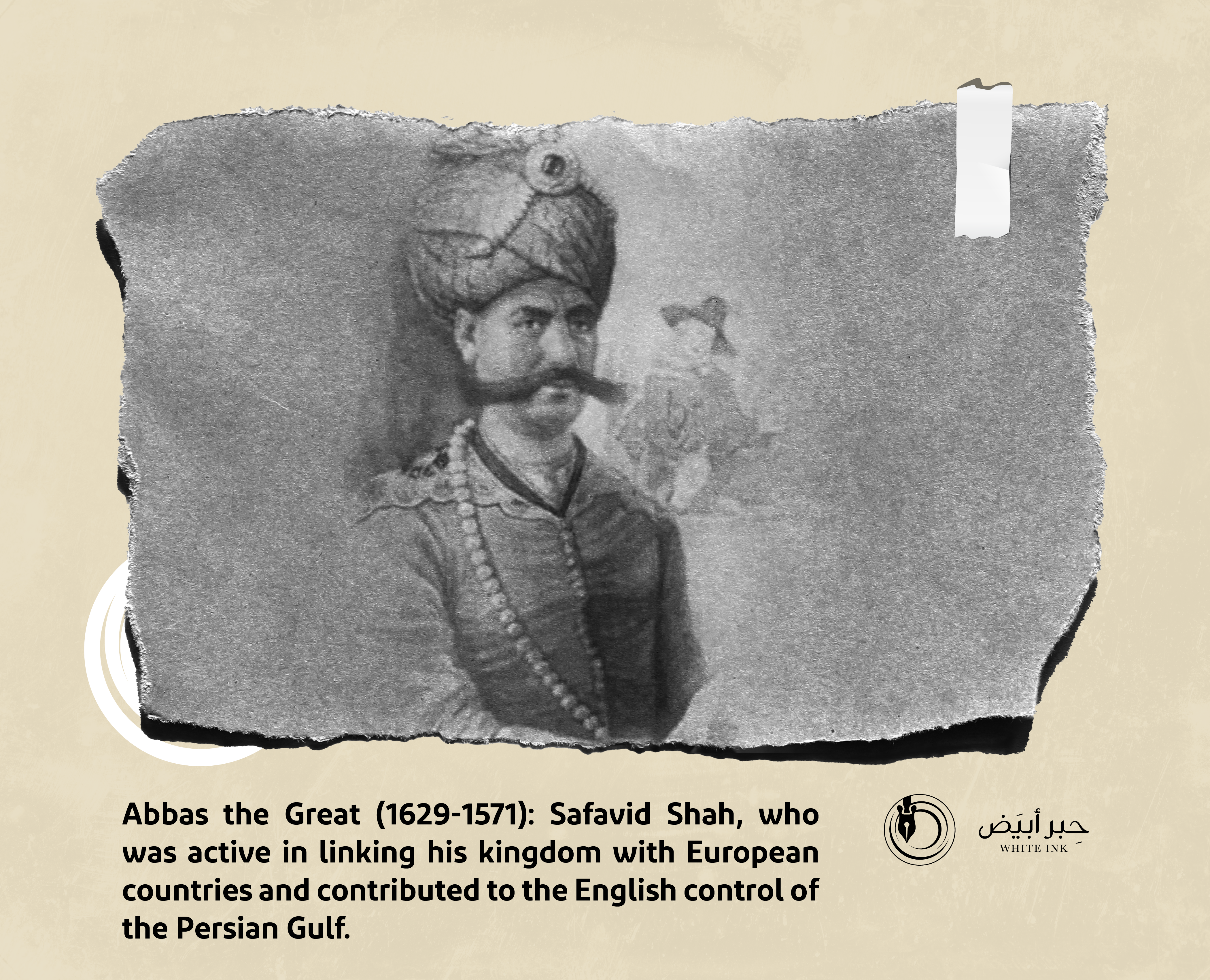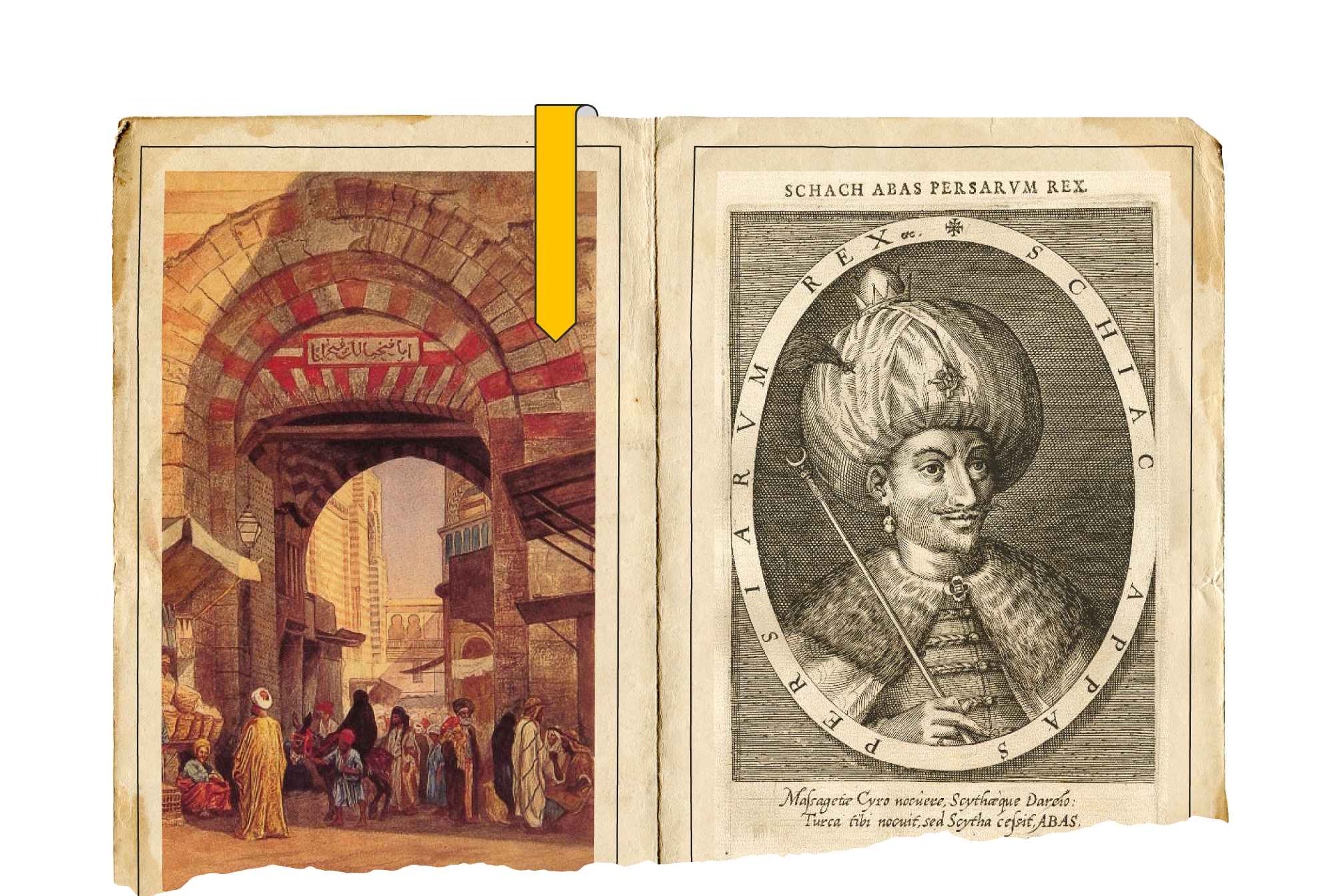
After they Allied with the Spaniards
Safavids Translated Extremism Against the Muslim Arabs
At the beginning of the sixteenth century, Shah Ismail Al-Safavi took a strange and exciting step that changed the course of Iranian history. He imposed a change in the official doctrine and persecuted the followers of the Sunni sect, which, until that time, was the most prevalent sect in all parts of Iran. Actually, the religious sectarian factor was not the motive behind this dangerous transformation, as some consider that the Safavids are the farthest from the Twelver doctrine.
The famous French historian Gramon confirms this, describing the Safaviyya, saying that: It is “the strange hybrid doctrine advocated by the Safavi, in which one finds pre-Islamic local beliefs, mixed with other beliefs from the ancient shamanism characteristic of the inhabitants of the wilderness, all covered by a light coating of a Shi’ite Islam. Yet it is very alien to Twelvers”.
Thus, it becomes clear to us that the Safavid project is farthest from Islam, and even from the Shiite sect itself and that, in reality, it is nothing but a political project, an expression of the extremist Persian tendency coming from the pagan era.
Hence, it was not surprising that Shah Ismail Al-Safavi allied with the enemies of Islam, especially the new European Crusader powers, led by Spain. He also offered an alliance with Hungary and sent two letters to Spain and Hungary requesting a treaty of friendship and cooperation between them against the Arab world.
This sinful alliance reaches its climax in the era of Shah Abbas the Great, who is considered one of the great new kings in Iranian history; prompted by political pragmatism to ally himself with Spain, the first Crusader power in the modern era and the greatest enemy of Islam and Muslims, It is necessary here to point out the role of the Spanish Crusaders in expelling Muslims from Andalusia, in addition to their desperate attempts to force the remaining Muslims in Andalusia to convert from Islam and embrace Catholic Christianity. Also, we cannot forget the atrocities committed by Spain through what was known as the Inquisition, especially against Muslims.
Not only was Spain persecuting the Muslims of Andalusia, but it determined to invade Maghreb states, colonize its lands and terrorize its Muslims. Thus, Spanish invasions began to occupy the Islamic frontiers, trying to erase Islam from these parts. It is sufficient here to refer to what the Spaniards committed: for example, in terms of crimes against humanity when they occupied the city of Tunisia. About this, Shawky Al-Jamal says: “Tunisia was afflicted by the Spaniards with many types of destruction, as many religious monuments were destroyed therein, to the extent that they took Zaytouna Mosque as a stable for their horses and destroyed the precious books, carrying some of them to Rome and giving them as presents to the Vatican.
Despite this disgraceful history of Catholic Spain, stained with the blood of Muslims, Shah Abbas Safavid did not object to communicate, even ally, with Spain within the framework of his pragmatic political project to control the Islamic world.
Thus, Safavid Iran and Crusader Spain began exchanging political missions, messengers, and messages of political deals since Abbas came to power and the pace of that matter increased with the union of Portugal with Spain and Spain inherited Portuguese influence in the Arabian Gulf.
To emphasize the religiousness of the Safavid project and its political pragmatism, we mention here this important and indicative incident. A Spanish mission came to the Safavid court in (1602) and requested the construction of a Catholic church in Iran for “Christianization”. However, Shah Abbas pretended to refuse, explaining his refusal by his fear of the objection and anger of the Shiite clergy. However, with great malice and political Machiavellianism, he presented this proposal to the Spaniards : “If you happen to help Iran in its wars against the Ottoman Empire, it would then be possible to build several churches, not one church, in Iran, without fear of the Shiite clergy”.
In one of the Iranian missions to the Spanish court, Iranian delegation submitted a request to Spain to send Spanish and Portuguese ships to attack the ports of the Red Sea and work to close Islamic navigation in this sea.
Shah Abbas Safavi also made an offer to the Spaniards through the Venetians that included Iran and Spain sharing the western and eastern worlds. According to that offer Iran takes over the Asian part, while Spain is in Europe.
Safavid state planned to close the Red Sea and besiege the Islamic world to control it and its wealth.

In fact, this alliance between Safavid Iran and Crusader Spain revealed the true face of the political pragmatism of the Safavid project and the decline of Safavid Iran’s status as an Islamic power. Thus, the features of anti-Islam and anti-Muslim Safavid political project becomes evident, which does not hesitate to ally with the European West to serve its extremist Persian interests against Arabs and Muslims.


- Badih Jumaa, Ahmed Al-Khouli, History and Civilization of the Safavids (Cairo: N.P and N.D).
- Shawqi El-Jamal, Great Arab Maghreb from the Islamic Conquest to the Present Time (Cairo: Anglo Bookshop, 1977).
- Abdel Aziz Nawar, History of Islamic Peoples in the Modern Era (Cairo: Dar Al-Fikr Al-Arabi, 1998).
- Omar Abdel Aziz, Lectures on the History of Islamic Peoples (Cairo: Dar Al-Maarifa, N.D).
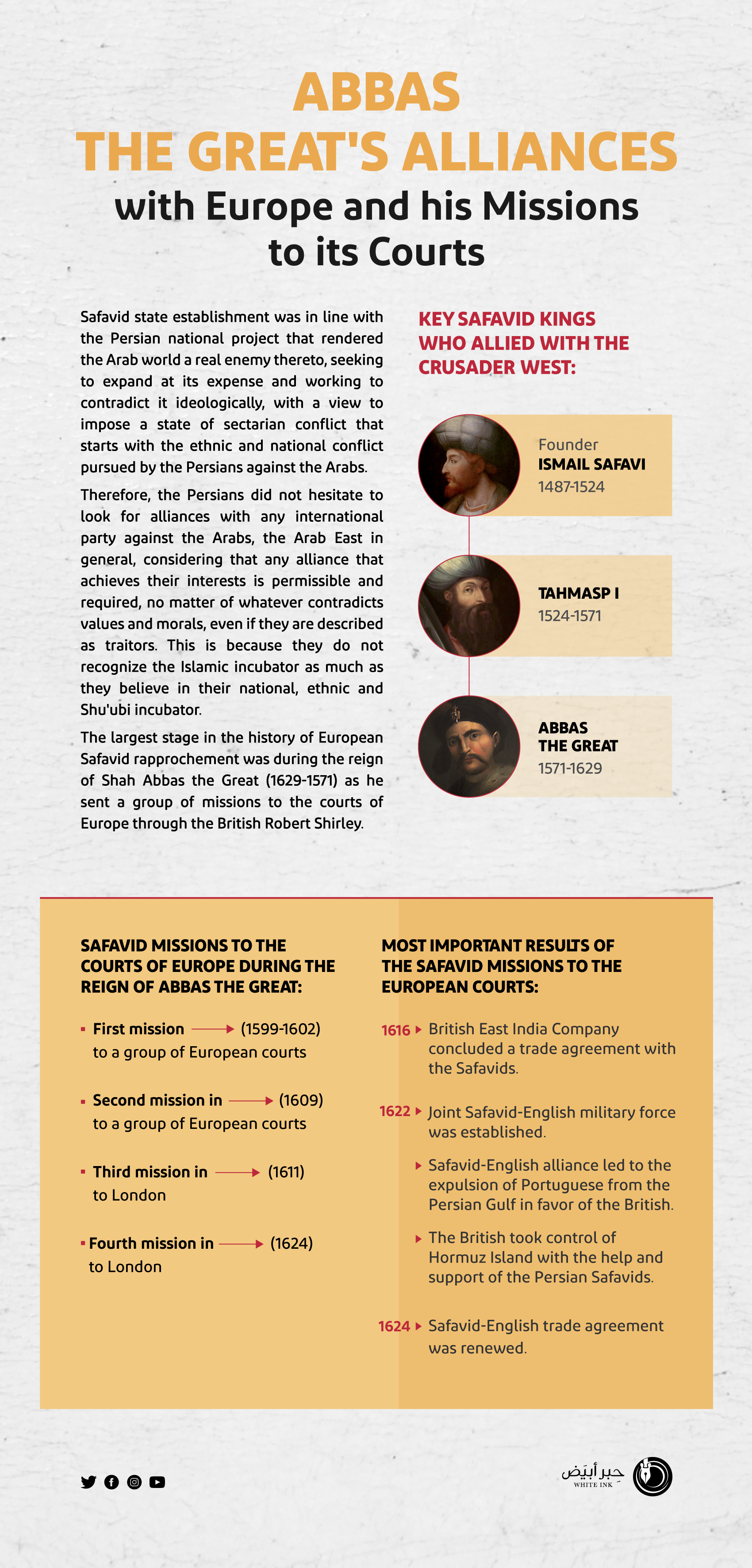
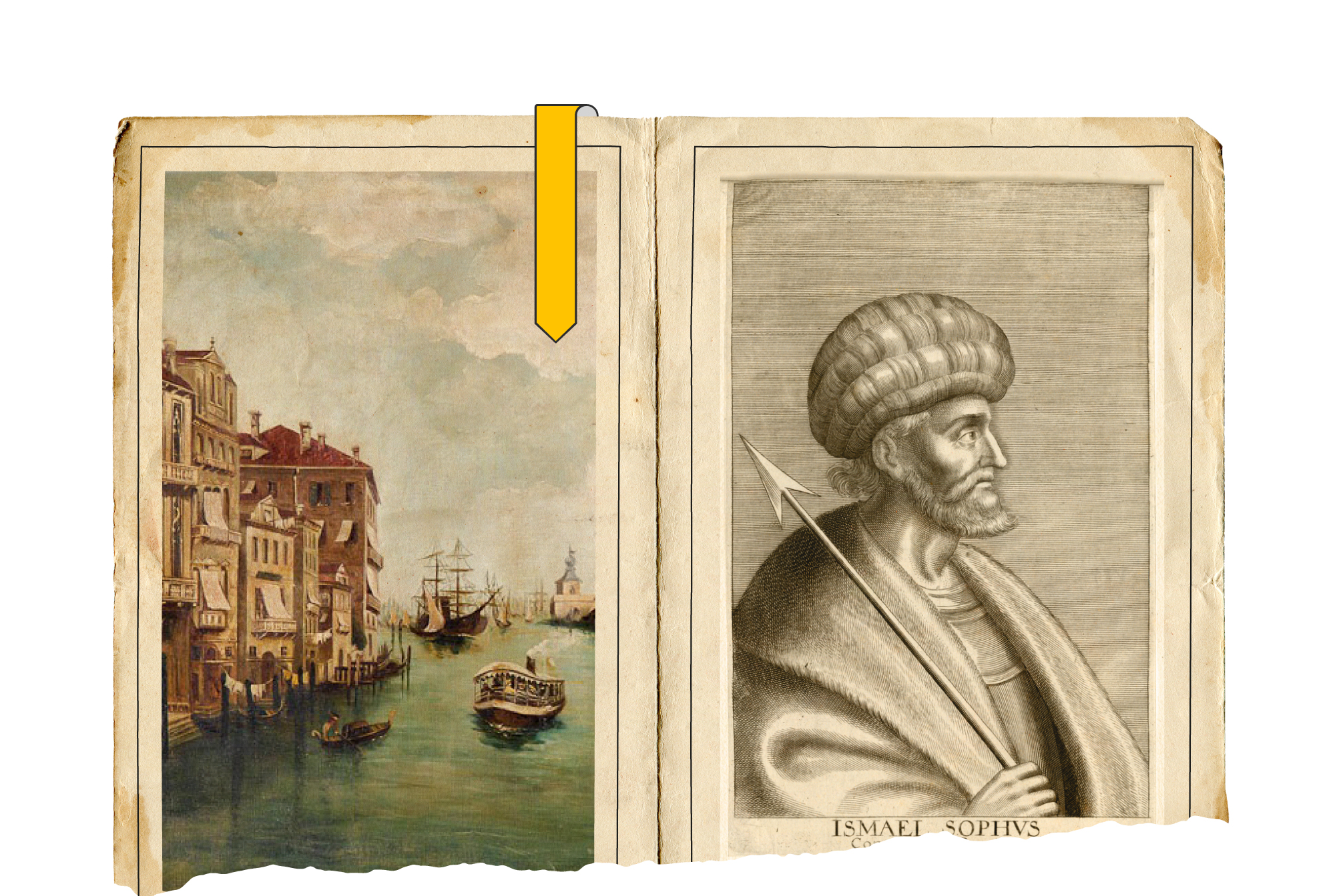
Safavids made
All Concessions to the Europeans to Surround the Arab World
Alliances of Safavid state in the European periphery did not only represent political relations, but were a Safavid strategic choice to demolish Islam and eliminate it in its infancy after the Safavid state was established as a satanic plant on the borders of the Arab world until it reached its negative impact on the independence of the Arab world. That impact is still valid till today, as an inevitable result of their alliance with European colonialism at the height of its colonial ambitions and its targeting of the Arab world from the Persian Gulf to Morocco at its extremity.
Safavids, like their Persian ancestors, saw Islam as the cause of destruction of their Persian empire and believed that the elimination of the Arabs was the basis from which they proceeded to return to their ancient glories as they claim. On the other hand, the Europeans saw that their return to the Holy Land in Palestine and the launching of the Crusades must pass through the elimination of the Muslim Arabs and the return of the Roman Empire to its ancient borders in the East, as it was before the advent of Islam.
When the Safavid state began its foreign relations, it did not seek understanding with its Arab Muslim neighbors, but rather went for an alliance with the Crusader states in Europe that brought down Andalusia and began establishing fleets to reach the Arabian Peninsula, as confirmed by Portuguese documents.
Whoever monitors the Safavid mentality, and how it managed its relations with its neighbors and with the international space at the time, will find that it fought its Arab Islamic surroundings and immediately built strategic relations that reached the point of alliance with Austria, Portugal, Hungary and Italy; alliances of interest between both parties whose first enemy was the Arabs.
Alliance with the Crusader powers had become a feature that distinguished the Safavid state, which saw that rapprochement with the Crusaders was more beneficial to them than their rapprochement with the Muslim Arabs, while the Arab and Islamic states were in dire need to confront the new crusades that came with Spain, Austria and Portugal, which succeeded in overthrowing Andalusia and was on the way to occupy other Muslim states and peoples, which was actually achieved in the decades following the ill-fated alliance.
Safavid state did not stand neutral between the Crusaders and the Arabs, though it was possible, but rather took a biased and hostile stance in alliance with the Europeans, weaving conspiracies against the Arabs, entering into military agreements with European states to eliminate the Islamic forces and preparing the land for them, as it did when it was granted the Portuguese the right to dispose of Hormuz Island in the Persian Gulf, which it later turned into a platform for the occupation of the Arab coasts from the western colonial. Several political historians note that the Safavids were the ones who introduced colonial powers to the Persian Gulf region, after paving the way by concluding military and commercial alliances with the Portuguese, the Dutch and the British. Perhaps the most prominent of these conspiracies occurred during the reign of Shah Ismail the Safavids, after the bitter defeat that befell him in the battle of Chaldiran in (1514); as he moved immediately to ally with Portugal to cover his defeat.
Persian agreements against the Islamic world in the era of the Safavid state were shameful.

Agreement with Venice
Safavids’ agreement with the Republic of Phenicia (Venice) was shameful, as described by many historians, at all levels. Venice was in its worst economic and military state following the elimination of the Byzantine state and the closure of the main trade route between Europe and Asia. Hence, Shah Ismail sent ambassadors to the Venice court as a lifeline for them, asking them to attack the east by sea, where he attacks from the land side, provided that Venice shall regain its lost bases in the Mediterranean.
Safavid Shah, Abbas, also had several contacts and conspiracies with the Crusaders and made offers to the Spaniards through the “Venetians” to share the Arab lands, so that the first would attack from the European part while he monopolizes the Asian part. That offer was only one of many offers carried by Iranian ambassadors to Europe.
Historian Abbas Iqbal says in his book, History of Iran after Islam: “Shah Ismail is undoubtedly considered one of the greatest kings of Iran. Although he crossed the path of fairness and chivalry in imposing the doctrine of Shiism on the people of Iran, most of whom until that time were Sunnis, so he shed the blood of many innocent people with harshness, yet his policy in that regard, i.e. creating sectarian unity in Iran and making the Shiite sect an official sect, in addition to choosing the path followed by his successors, led to a very important result, which is protecting Iranian society from the evil of fanatics’ attacks, who called themselves, from the late era of Sultan Selim, the princes of the believers and the caliphs of all Muslims. They claimed that all Muslims must obey them with out of faith and creed, as was the people in the time of the Abbasids, and that they have to acknowledge that carrying out the Sultan’s orders is a religious duty, after following the judgment of Allah and His Messenger. The policy of the Safavid kings prevented Iranian people from being deceived thereby and getting involved in losing their independence in Sunni community. Add to this, they have always been courting and associated with the European Christians states, receiving their ambassadors and sending them their envoys. By this way, Iran knew about Europe, which was in a state of sophistication and advancement, in prelude for the transfer of some means of the new civilization to Iran.
In the book, History of Iran, Shahin Makarios mentions that Shah Abbas issued a circular to his subjects saying: “The Christians are his friends and allies of his country and that he commands his subjects to respect and honor them wherever they go. In continuation of this policy, the Shah opened the ports of his country to European merchants and recommended that no duties would be taken therefrom on their goods and that none of the rulers or the people should harm them.” Makarios says: “Shah Ismail was the first to do this openly”.


- Bassem Hamza, “Iran’s Military, Doctrinal and Domestic Policy and Its Impact on Foreign Policy during the Reign of Shah Ismail Al-Safavid 1501-1524”, Journal of Iranian Studies, University of Basra, Issues 10-11 (2009).
- Shawqi El-Gamal, Great Arab Maghreb from the Islamic Conquest to the Present Time (Cairo: Anglo Bookshop, 1977).
- Abdel Aziz Nawar, History of the Islamic Peoples in Modern Era (Cairo: Dar Al-Fikr Al-Arabi, 1998).
- Muhammad Suhail Takush, History of the Safavid State in Iran (Beirut: Dar Al-Nafais, 2009).
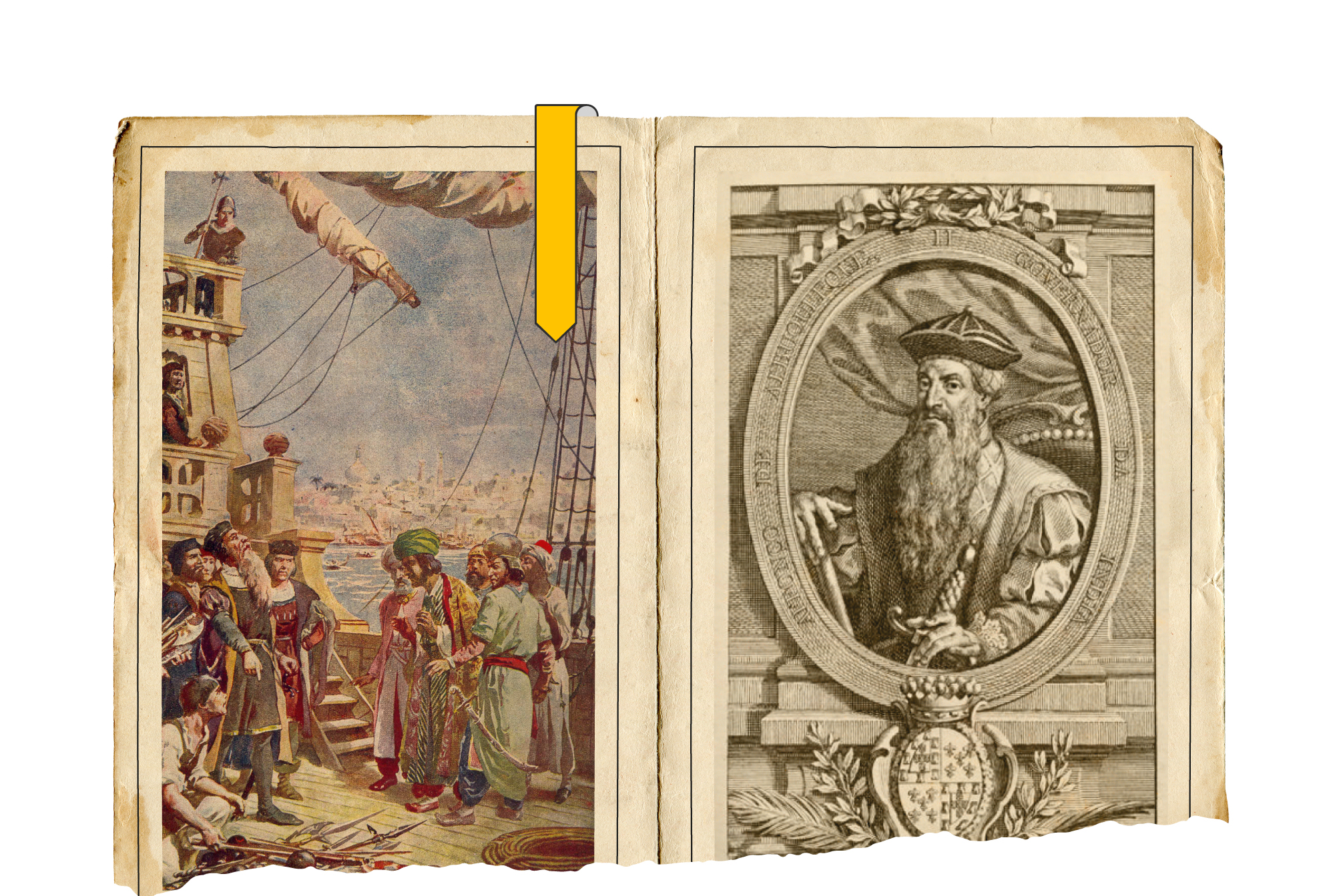
Safavid State
Long History of Treachery Against the Arab and Islamic world
History books tell us about complicity and betrayals that took place with the occupying Crusader West, in greed for the bounties of the Arab and Islamic world. Evidence confirms that betrayals were odd cases that peoples deny and the “traitor” is always ashamed thereof. Therefore, Islam made treason one of the three signs of a hypocrite. Yet, what distinguishes the external political expression of the Persians is their hostility and existential hatred for everything that is Arab or Islamic. Therefore, the series of conspiracies with the Crusader West formed a firm belief that hardly any Persian ruler deviated from, especially since the dropping of the myth of the Aryan race with the epic of Qadisiyah in the year 15 AH (636 AD).
The control of the Arabs over most of the ancient international trade axes until the fifteenth century AD, “the most important of which is the Red Sea road, which Egypt lies at its northern end and Yemen occupies its southern end, made colonial eyes focus on this region to subject it to foreign influence”. Perhaps the contexts of the strategic environment in the Eurasian region, especially in the sixteenth century AD, made the “geostrategic actors” determined in Persian Iran, the Ottoman Sultanate, some European powers, and, to a lesser extent, Mamluks in the Levant and Egypt. If the objectives of the Ottoman Sultanate were clear in expanding west and south, then Iran and the Crusader West found themselves in front of an objective alliance that aimed at eliminating what they considered an existential threat.
Portugal, greedy for warm Arab waters, remained in a state of anticipation of any anticipated confrontation and “the situation continued without a clash, as if each of them was in a state of anticipation, feeling the pulse, waiting for the opportunity and preparing to attack its opponent, until the year 1525 AD”.
The Persians read very well the nature of the Portuguese goals and saw that it was summarized in reaching the Arab coasts, considering Portugal a primarily a naval power and not a land power. Therefore, influence can be shared between both parties.
Honesty in proposition prompts us to hold the Ottoman state responsible as it contributed to perpetuating the state of Islamic dissonance in the East at the expense of the Christian bloc in the West. Some researchers believe that “the Islamic world in the East did not reach the stage of solidarity in adversities, but rather the opposite occurred, which is a state of rivalry and competition, which weakened the Islamic front in the East against the European invasion of all its groups, especially the Church”.
Ottomans took advantage of the Portuguese attacks on the vital field of the Mamluks, thus contributed to the weakening of their influence, and took possession of the areas that were subject to the Mamluks in the Levant, Egypt and Hijaz. In the same contexts of weakening the Islamic front in the East, the Persian state strengthened its alliance with the Crusader West against the Ottoman Empire, which is deemed an extension of the historical identification between the Persian and Western agendas.
Persian conspiracies with the Crusader West succeeded in stopping the attacks in the direction of the east and also contributed to the failure of the siege of Vienna after the Ottoman Sultan was forced to return to protect his eastern borders upon the frequent news about an imminent movement of the Persians to incursion into the Ottoman regions. Safavid-Portuguese alliance remains a model for alliances that targeted the Arabs in particular, in light of the racist and bloody dealings of the Portuguese against the Arabs at the hands of Vasco De Gama, as well as in light of the Persian hatred against the Arabs, which is self-explanatory.
Western countries supported the Safavids and were optimistic about allying therewith.

In this context, the Safavid-Portuguese alliance was crowned with the agreement concluded between Shah Ismail the Safavid and Albuquerque, the Portuguese ruler in India, which stipulated the following:
- A Portuguese naval force shall accompany the Safavids in their campaign against Bahrain and Qatif.
- Portugal shall cooperate with the Safavid state in putting down (rebellion) movements in Baluchistan and Makran.
- Both states shall unite in confronting the Ottoman Empire.
- Iranian government (the Safavids) shall disregard the Hormuz Islan, provided that its ruler shall remain subordinate to Portugal, and that it shall not interfere in its internal affairs.
The Crusader West was optimistic about the growth of the Safavid state and saw therein the best “reliable” ally to continue exhausting and blackmailing the Arab and Islamic world, especially as it saw that Sunni Islam is strong religious incubator and a unifying factor that possesses a great spiritual center of gravity represented in the heart of the Islamic nation, the Two Holy Mosques”.


- Ahmed Al Shamsi, Portuguese-Ottoman Conflict in the Sixteenth Century, Center for Studies and Documentation, Ras Al Khaimah, United Arab Emirates (2013).
- Kamal Al-Sayed, Rise and Fall of the Safavid State (Qom: Fadak Library, 2005).
- Ali Darwish, Politics and Religion During Safavid State Establishment (Beirut: The Arab Center, 2013).
- Group of researchers, The Safavids.. History, Conflict and Impacts, 3rd Edition (Dubai: Al-Mesbar Center, 2011).



